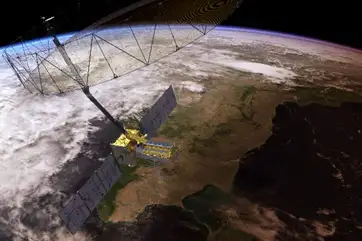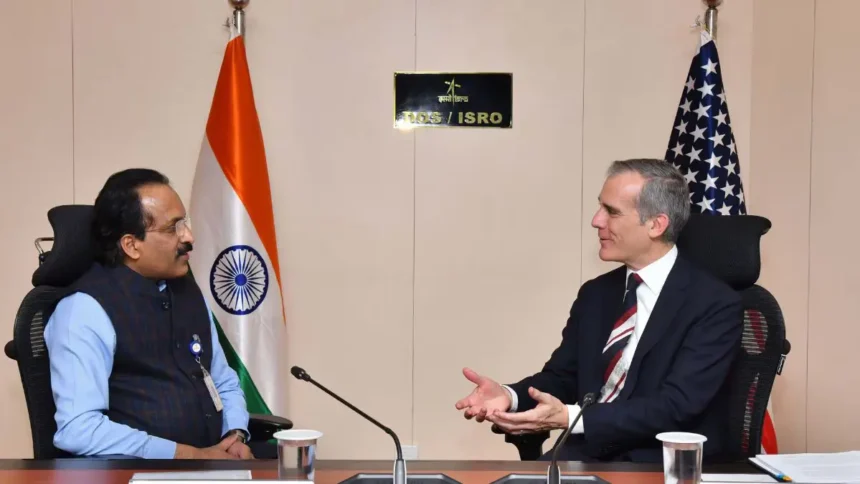In a significant development, the United States’ National Aeronautics and Space Administration (NASA) is gearing up to provide advanced training to Indian astronauts. The goal? A joint mission to the International Space Station (ISS). US ambassador Eric Garcetti, made this announcement during the “US-India Commercial Space Conference: Unlocking Opportunities for US & Indian Space Startups” held in Bengaluru on Friday.
The Promise of Collaboration
Garcetti emphasized that this training initiative was one of the promises made during the visit of Indian and US leaders. The joint effort aims to mount a mission to the ISS, with hopes of achieving this milestone either later this year or shortly thereafter. The collaboration between NASA and the Indian Space Research Organisation (ISRO) is set to strengthen further with this training program.
NISAR Satellite and Earth Observation

During his address, US ambassador Eric Garcetti also highlighted another exciting development: the upcoming launch of the NISAR satellite from ISRO’s Satish Dhawan Space Center. NISAR stands for “NASA-ISRO Synthetic Aperture Radar,” and it represents a joint Earth-observing mission. NISAR’s primary mission is to track movements of Earth’s land and ice surfaces with exceptional precision. It will monitor nearly every part of our planet at least once every 12 days.
The satellite will monitor various resources, including ecosystems, the Earth’s surface, natural hazards, sea level rise, and the cryosphere. This cutting-edge technology underscores the commitment to peaceful space exploration and scientific advancement.
In another significant move, Eric Garcetti proposed the development of a “QUAD satellite” in collaboration with India. During his official visit to Bengaluru, he met with Indian Space Research Organisation (ISRO) Chairman Dr. S Somanath to discuss this exciting initiative.
What Is the QUAD Satellite prosed by US ambassador Eric Garcetti ?
The Quad, short for the Quadrilateral Security Dialogue, is a strategic forum comprising the United States, Japan, India, and Australia. Formed in 2007, the Quad aims to promote a free, open, and rules-based Indo-Pacific region. In recent years, the Quad has expanded its focus to include critical and emerging technologies, including space.
The QUAD satellite represents a joint effort involving India, the United States, Japan, and Australia. Its purpose is to enhance space exploration, scientific research, and cooperation among these nations. The proposal aims to leverage each country’s expertise and resources to create an advanced satellite capable of various missions. Let’s know more about the nd for a quad satellit in the Indo-Pacific region.
The Need for a Quad Satellite
Space-based assets play a crucial role in modern geopolitics, from communication and navigation to surveillance and scientific research. Recognizing this, the Quad leaders have proposed the development of a dedicated Quad satellite. Let’s delve into the details:
1. Maritime Domain Awareness
- The Quad satellite would enhance maritime domain awareness (MDA) across the Indo-Pacific. By providing real-time data on ship movements, fishing activities, and potential security threats, it would bolster regional security.
- MDA is essential for monitoring illegal fishing, piracy, and other illicit activities. The satellite’s sensors would track vessels, identify patterns, and enable timely responses.
2. Communication and Connectivity
- Reliable communication is vital for disaster response, coordination during crises, and economic development. The Quad satellite would improve connectivity by:
- Facilitating high-speed internet access in remote areas.
- Supporting disaster management and relief efforts.
- Enabling seamless communication between Quad countries.
3. Surveillance and Intelligence
- The satellite’s sensors would provide valuable intelligence, surveillance, and reconnaissance (ISR) capabilities. Key features include:
- Monitoring military activities, including naval movements and troop deployments.
- Detecting environmental changes (e.g., deforestation, pollution, and climate patterns).
- Tracking potential security threats (e.g., missile launches or illegal border crossings).
4. Technological Advancements
- The Quad satellite would incorporate cutting-edge technologies:
- Synthetic Aperture Radar (SAR): SAR can penetrate clouds and provide high-resolution images, even in adverse weather conditions.
- Electro-Optical/Infrared (EO/IR) Sensors: These sensors capture visual and thermal data, aiding surveillance and target identification.
- Secure Communication Links: Ensuring encrypted communication channels for sensitive data.
5. Collaboration with ISRO
- The Indian Space Research Organisation (ISRO) would likely play a significant role in developing and launching the Quad satellite.
- ISRO’s expertise in satellite technology, launch vehicles, and cost-effective solutions makes it an ideal partner.
- Collaborative efforts would pool resources, share knowledge, and accelerate the project.
- The Quad’s focus on outer space matters encourages private enterprise.
- India can engage with other Quad countries to strengthen its private space sector.
Some challenges might also be encountered in the future. The Quad’s focus on countering China’s influence in the Indo-Pacific may raise tensions. Balancing cooperation with regional stability and avoiding direct confrontation will be crucial.
The Quad satellite represents a significant step toward strengthening regional security, connectivity, and cooperation. As the India will work with other Quad countries, they will demonstrate their commitment to a free and prosperous Indo-Pacific.
Remember, the Quad Leaders’ Summit has already emphasized space as one of their major initiatives. The proposal for a Quad satellite aligns with their vision for a secure and technologically advanced region.
Advanced Detectors and Packaging Technologies
During the meeting with US ambassador Eric Garcetti, Chairman Somanath highlighted the opportunity for developing advanced detectors and packaging technologies in collaboration with U.S.-India academic institutions. These technologies would enhance the satellite’s capabilities and ensure its successful deployment.
Prosperity and Jobs in the Space Sector
US ambassador Eric Garcetti also underscored the economic potential of space exploration. He stated that startups in the space sector could create good-paying, high-tech jobs for both Indians and Americans. The Artemis Accords, which outline a framework for safe lunar exploration and beyond, serve as a testament to the shared vision of the two nations. The conference in Bengaluru brought together senior officials from the US and Indian governments, along with representatives from NASA, the National Oceanic and Atmospheric Administration (NOAA), and industry stakeholders.
Commercial Space Endeavors and Gaganyaan Cargo Module
The discussions also touched upon fostering commercial space activities. Chairman Somanath explained that payload technology and space-bound hardware are now being built in Indian facilities outside ISRO labs. India plans to source payloads and satellites from Indian companies, enabling them to enter the global market. Additionally, NASA’s participation in India’s proposal for a G-20 satellite for environment and climate change was discussed.
India-US Recent Space Diplomacy
The United States and India have been actively engaging in space diplomacy, forging closer cooperation in various aspects of space exploration. Here are some key developments:
- Artemis Accords and Joint ISS Mission:
- During Indian Prime Minister Narendra Modi’s summit with U.S. President Joe Biden in Washington, D.C., a major step forward in bilateral space cooperation was announced. India signed the Artemis Accords, and the two countries’ space agencies plan to pursue a joint mission to the International Space Station (ISS) in 2024.
- The Artemis Accords outline principles for safe and sustainable lunar exploration, emphasizing international collaboration.
- U.S.-India Space Technology Industry Workshop:
- In April 2023, the U.S. Department of State Export Control and Border Security Group (EXBS) and the Department of Commerce’s Bureau of Industry and Security (BIS) hosted a workshop on export controls in the space sector.
- The goal was to expand India’s commercial and defense cooperative engagement in space, fostering public-private collaboration.
- Space Situational Awareness (SSA):
- The Space Situational Awareness Arrangement, signed in April 2022 during the India-U.S. 2+2 Ministerial Dialogue, has provided a platform for enduring convergence in the space sector.
- India’s Network for Space Object Tracking and Analysis (NETRA) control center, established by the Indian Space Research Organization (ISRO) in Bengaluru, collaborates with the United States’ Combined Space Operation Center (CSpOC) at Vandenberg Air Force Base in California.
- SSA activities enhance space safety and security by tracking and monitoring space objects.
- NISAR (NASA-ISRO Synthetic Aperture Radar):
- NISAR, currently in development, represents a milestone in India-U.S. space partnership. It aims to observe complex Earth phenomena, including hazards and global environmental damage.
- This joint mission will provide valuable data for scientific research and resource management.
- Earth and Space Science Collaboration:
- While joint-military space asset development is not a high priority, India and the U.S. are strengthening bilateral cooperation in areas such as:
- Human space exploration
- Global navigation satellite systems
- Spaceflight safety
- Policies for commercial space
- While joint-military space asset development is not a high priority, India and the U.S. are strengthening bilateral cooperation in areas such as:
Space diplomacy has become a key pivot in the evolving India’s foreign policy, involves working together with nations like US to explore the cosmos and advance scientific knowledge. There have been periods of strain due to US restrictions on technology transfer, but overall cooperation has grown in recent years.
The US has a robust private space industry, and India is looking to grow its own. Collaboration could involve knowledge sharing, joint ventures, and creating a framework for facilitating space commerce between the two nations.
A growing space diplomacy between India and the US, like this visit of US ambassador Eric Garcetti create positive impacts on the overall relationship in several ways. Joint space missions and scientific collaborations often involve exchanges between scientists, engineers, and students. This will strengthen people-to-people ties and foster a spirit of cooperation. Successful joint missions and collaborative projects will foster trust and confidence between the two nations, which can have positive spillover effects on other aspects of the India-US relationship in future.










